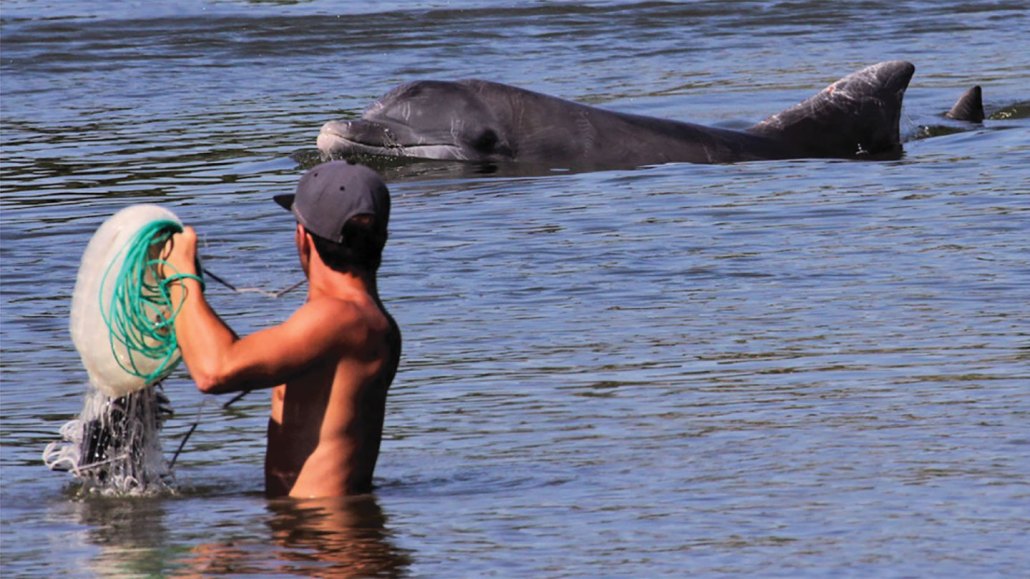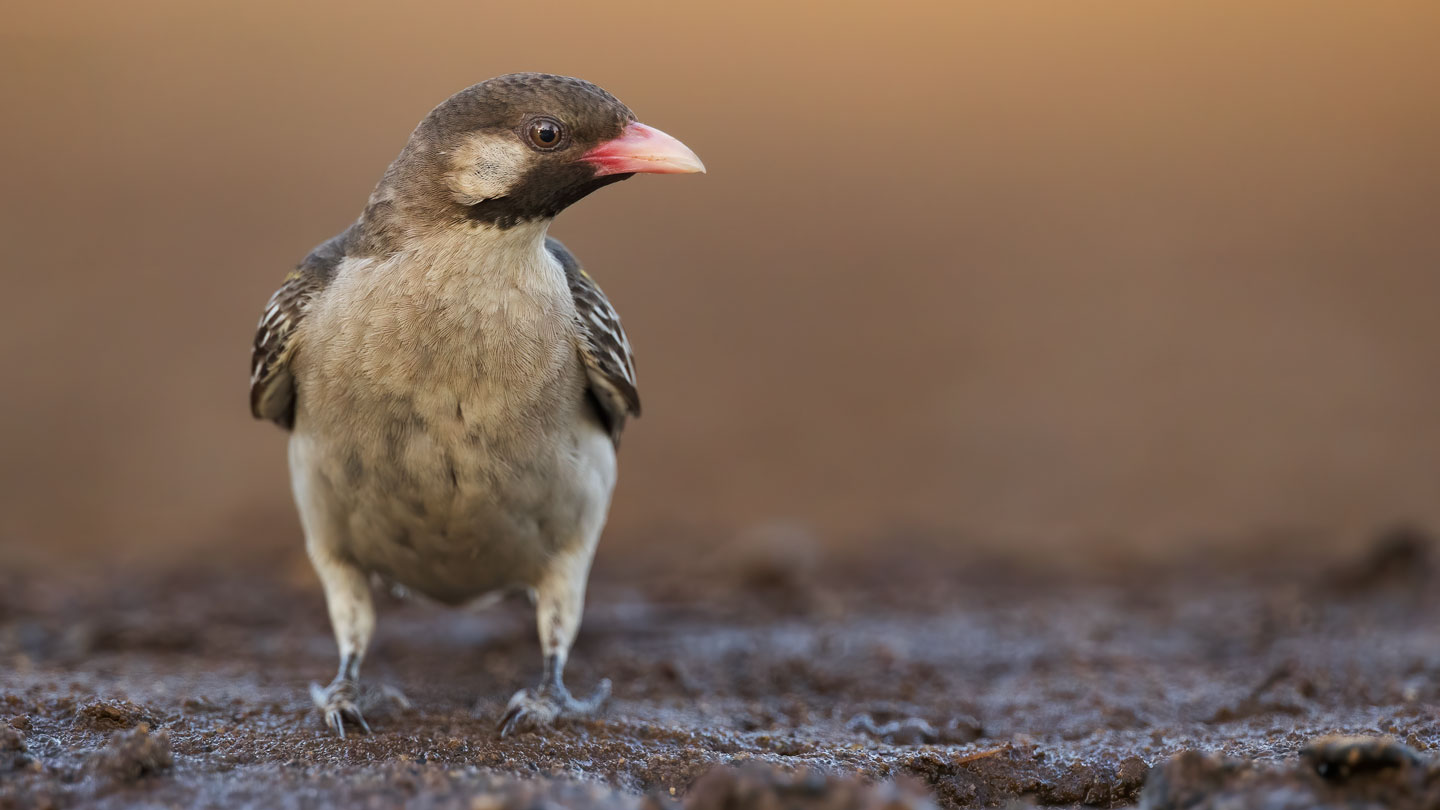
Fishers (one shown) in the southern Brazilian city of Laguna work together with dolphins to catch elusive mullet.
M. Cantor et al/PNAS 2023
- More than 2 years ago
Read another version of this article at Science News Explores
We’ve all heard that dogs are a man’s best friend, but our canine companions don’t make up the entirety of humankind’s friend circle. Humans have cooperated with wild animals throughout our evolutionary history, forming reciprocally beneficial relationships known to biologists as mutualisms.
One particularly piscine partnership that made headlines recently can be found in Brazil, where fishers catch nets full of fish with the aid of the local bottlenosed dolphin (Tursiops truncatus gephyreus).
This team-up started over a century ago, probably when fishers first noticed that the presence of dolphins was a clue that fish were hiding in the murky water, says Mauricio Cantor, a behavioral ecologist at Oregon State University’s Marine Mammal Institute in Newport.
“The dolphins are really good at detecting fish and herding them toward the coast,” he says, “and the fishers are really good at trapping the fish with their net.” Once the fish are mostly secured in the net, the dolphins are sure to snag a few for themselves.
In a study published January 30 in the Proceedings of the National Academy of Sciences, Cantor and colleagues used long-term data to show that the dolphins and fishers respond to cues from the other, and without experienced partners who know the right dance steps, the routine falls apart. “This is a really remarkable and impressive study,” says Pat Shipman, an anthropologist at Penn State University who was not involved with the research.
This fishing partnership is an important part of the cultural identity of both the fishers and the dolphins, but Cantor and his colleagues’ work shows that the practice is in decline. And among human-animal partnerships, it’s not alone. “Most of the historical cases are declining or already gone,” Cantor says.
Given their rarity and charm, let’s take a look at some of the other known examples of human-animal cooperation.
People used to team up with orcas to hunt whales in southeastern Australia
The bottlenosed isn’t the only dolphin that humans have formed beneficial arrangements with. In the 1800s, several hunters began working with a pod of orcas (Orcinus orca) to catch large whales. At Twofold Bay in southeastern Australia, some orcas would find and harass a whale to tire it out, while others swam to alert whaling crews (made up of Aboriginal Australians and Scottish immigrants) that they’d found prey.
Once the whalers arrived and harpooned the whale, they let the orcas eat the tongue — a delicacy in the killer whale culinary world — before taking the rest for themselves.
While the dolphins and fishers in Brazil were chasing the same prey — schools of migratory mullet (Mugil liza) — the orcas and whalers were mostly after different things. The key similarity, Cantor says, is that there’s enough prey for everyone, so that no competition arises to spoil the partnership.
This relationship ultimately ended when some settlers killed two orcas, which drove the cooperative pod away from the bay, seemingly never to hunt with humans again.
These birds guide people to honey in Africa
Sometimes, a name says it all. Such is the case for the greater honeyguide (Indicator indicator), which has been labeled in both English and Latin based on its most famous trait. These birds live in sub-Saharan Africa, and cooperate with local honey hunters to gain access to succulent beeswax (SN: 7/21/16).
Birds, like humans, don’t like to be stung by bees, so a honeyguide that’s hankering for beeswax will chirp at a person to signal that they should follow. The honeyguide then leads the hunters to a bee nest and lets them do the dirty work of harvesting it.

Like with orcas, honeyguides and humans are after different parts of the prize: Humans want the honey, while the birds want the wax. Honeyguides are so helpful for finding bee nests that the Borana people of East Africa blow a special whistle called a “fuulido” to summon them when it’s time for a honey hunt.
Similar to the dolphins in Brazil, the relationship with honeyguides is an important part of many African cultures. Legend even has it that a scorned honeyguide, if denied beeswax on prior hunts, will lead the hunters not to delicious honey but instead into the jaws of a dangerous predator, like a lion.
Wolves and people were once on the same side when hunting big game
To see the most extreme outcome of human-animal partnership, take a look at 39 percent of the country’s beds, couches and backyards. That’s about how many households in the United States own a dog. But it turns out a canine doesn’t have to be domesticated to get along with humans; Indigenous stories from peoples in North America describe cooperating with gray wolves (Canis lupus) to hunt big game like elk and mammoths.
The wolves would run down the prey until it tired, and humans would make the kill once they caught up. Because these prey items were so massive (like the large schools of mullet), it didn’t matter that humans and wolves were after the same thing — there was plenty to go around.
Though this furry friendship doesn’t exist anymore, wolves are still important in many Indigenous cultures. Some even still continue the practice of leaving some meat for the wolves after a hunt.
Though human-animal partnerships are rare and on the decline, they “give us an illustration of how positive our human interactions can be with nature,” Cantor says.
For Shipman, the urge to engage with other animals is a defining trait of humanity. “It’s in some ways as fundamental to humans,” she says, “as being bipedal.”





